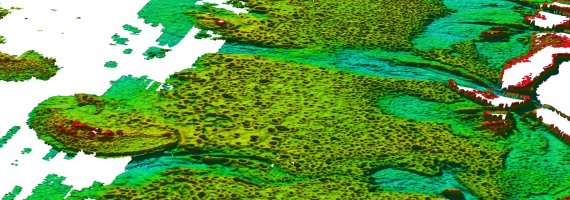Computer image of the new rif at Blight Reef on the north coast of Australia. Image: University of Queensland.
What kind of a reef is this?
‘It’s not a coral reef; it’s a halimeda reef, one based on the halimeda plant. It creates calcareous structures. When the plant dies, the calcium carbonate remains behind and sticks together to create the structures that have now been discovered. Scientists call them bioherms, stone mounds of organic origin.’
Are these structures completely new?
‘No, we’ve known about them since the 1980s. They are found between the coral reefs that make up the Great Barrier Reef, which stretches to a couple of hundred kilometres from the coast. These structures appear in the somewhat deeper sections in between. The stone mounds are about 200 metres wide and 20 metres thick.’
There is increasing interest in life in the twilight zones of the oceans.
Ronald Osinga
So what is new about this discovery?
‘The new aspect is that this is the first time they have been mapped in such detail. LiDAR was used for this. Like radar, only with light. Before, people were mainly using sonar to map the seabed. LiDAR gives a better picture and more detail. They thought there were about 2000 square kilometres of bioherms but that estimate has now been increased to 6000 square kilometres. A question of getting a better look.’
So there is still a lot to be discovered at the bottom of the ocean?
‘Yes. There is increasing interest in these kinds of mesophotic ecosystems: life in the twilight zones of the oceans. At depths between about 50 and 250 metres, life is not driven by light and completely different types of organisms dominate as a result. There is still loads to discover at lower depths too. Along with the Microbiology and Bioprocess Engineering groups, we are involved in a major European project on sponges in the North Atlantic Ocean.’

